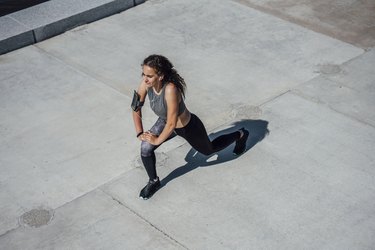
It's normal for your legs to feel a little heavy and tired after running. If you're a novice runner, sore legs after running is a sign that your body is getting used to a different type of physical stress. Pain that appears and disappears within a few days is known as delayed-onset muscle soreness (DOMS), which can also happen to more experienced runners if they increase the frequency or intensity of their running.
How to Prevent DOMS
Video of the Day
You can take steps to prevent DOMS or at least minimize its effects. One of the most important things to do before a run is to warm up properly. Do dynamic stretches to expand your range of motion and help avoid stiff, sore legs after running. For example, a hip-opener stretch targets your deep hip external rotators.
Video of the Day
In a standing position, bend your left knee and lift your leg to hip level; then rotate it out to 90 degrees. If you feel unsteady, put your left hand under your knee to guide it. Bring your leg back to the front of your body and then lower your foot and switch sides; repeat for 30 seconds.
You can also help prevent DOMS by increasing the intensity of your runs gradually. If you're a complete beginner, start with the run-walk method. For a 20-minute run-walk, spend a few minutes running and then walk for one minute, alternating until you reach 20 minutes and always finishing with a walk to cool down.
Read more: 12 Essential Tips for New Runners
Apply Heat or Cold to Sore Muscles
If you aren't sore after a run but want to reduce stiffness and pain, try a warm bath, a heat spray or a heat pack to help increase blood flow to your muscles. If you have DOMS, apply an ice pack (or ice cubes wrapped in a towel) to the affected area to prevent tissue damage. Apply ice for up to 20 minutes at a time, up to six times during a 48-hour period.
Just Keep Running
You can still go running with DOMS; you just have to take it easy. In fact, it may be beneficial to go for a gentle run, as it increases blood flow to your muscles, which boosts recovery. With time and consistent workouts at an appropriate intensity, your DOMS should diminish as your muscles adapt to the new activity.
Read more: How to Ease Muscle Soreness After a Workout
Stretch and Elevate Your Legs
To warm up before a run and after your post-run cool down, spend a few minutes stretching your legs to align collagen fibers, which accelerates recovery. Include stretches for your calves, hamstrings, knees and hips in your routine. If your leg pain is severe, elevate your legs above your heart after your run to decrease blood flow. This reduces swelling, which helps to alleviate stiffness and soreness.
Massage With a Foam Roller
Many runners swear by using a foam roller to alleviate DOMS. By improving circulation, massage helps reduce muscle swelling. Focus on the affected area by slowly rolling back and forth on the roller until you get relief.
For example, to relieve DOMS in your calves, sit on the floor with your legs straight out in front of you. Place the roller under your left calf, with your right foot on the floor. Press your hips off the floor with your hands; then roll all the way from your ankle to just below your knee. Repeat on your right calf.
Get Enough Rest
Rest is crucial to let your muscles recover from DOMS. Avoid anything but walking or very gentle running for a day or two to let the pain subside. While it's still possible to experience soreness, it will help you maintain your previous intensity and reduce the risk of more serious injury.
Check for a Running Injury
If you've tried these methods to ease leg pain after running but your legs are still sore, you may have a running injury. Visit your doctor or a physiotherapist for a professional diagnosis. Some of the most common running-related injuries are:
- Runner's knee
- Shin splints
- Plantar fasciitis
- Iliotibial band syndrome (ITBS)
- Achilles tendinopathy.
Runner's knee normally causes pain in or around the kneecap and may be caused by insufficient warm up or a bad running technique. Shin splints are characterized by aches or sharp pains in the shins and may be caused by a number of factors, including ill-fitting running shoes and running on a very hard surface.
Plantar fasciitis presents as stiffness or sharp pain in the heel or arch of the foot and is normally caused by unsupportive running shoes. ITBS may be the cause of pain around the outside of the knee due to inflammation. This is often the result of increased exercise intensity or anatomical issues. Achilles tendinopathy, which is often referred to as achilles heel, is characterized by pain in the back of the heel and may be caused by too much stress on the muscle.
- Runners World: The 5-Minute Warm-Up Routine You Should Be Doing Before Every Run
- Runner's World: 6 Beginner Running Tips to Help You Get Started
- Runner's World: How to Use a Foam Roller to Warm Up and Cool Down
- WebMD: Sore Muscles? Don't Stop Exercising
- WebMD: 10 Common Running Injuries: Prevention and Treatment
- Wimbledon Clinics: Dealing With Sore and Stiff Legs After Running
Is this an emergency? If you are experiencing serious medical symptoms, please see the National Library of Medicine’s list of signs you need emergency medical attention or call 911.